

Blended-classrooms - The Flipped Classroom. The flipped classroom is an exciting new instructional approach.

Flip teaching « Personalizing Learning. Time together in the classroom is precious–and it must be protected.
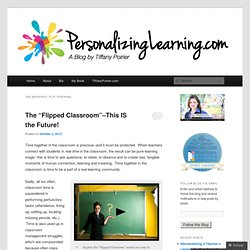
When teachers connect with students in real time in the classroom, the result can be pure learning magic: this is time to ask questions, to relate, to observe and to create real, tangible moments of human connection, learning and meaning. Time together in the classroom is time to be a part of a real learning community. Explore the “Flipped Classroom” model as a way to increase time for meaningful dialogue with students and more personalized learning in the classroom. Sadly, all too often, classroom time is squandered in performing perfunctory tasks (attendance, lining up, setting up, locating missing pencils, etc.). Time is also used up in classroom management struggles, which are compounded because often class sizes are just way too big. It can be hard to feel like an individual when you are just one of many students competing for the teacher’s attention.
This has to change. Ms. Teaching is facilitation. Flipped Classroom: Beyond the Videos. Last week, I read an interesting blog post by Shelley Blake-Plock titled “The Problem with TED ed.”
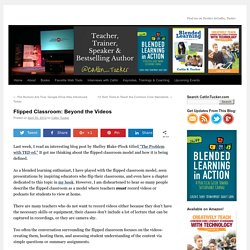
It got me thinking about the flipped classroom model and how it is being defined. As a blended learning enthusiast, I have played with the flipped classroom model, seen presentations by inspiring educators who flip their classrooms, and even have a chapter dedicated to this topic in my book. However, I am disheartened to hear so many people describe the flipped classroom as a model where teachers must record videos or podcasts for students to view at home. There are many teachers who do not want to record videos either because they don’t have the necessary skills or equipment, their classes don’t include a lot of lecture that can be captured in recordings, or they are camera shy. The flip chart as a teaching resource. Introduction It is now understood that education is a vital element for the development of peoples, so that their study is necessarily the key to achieving goals of progress of nations.

The didactic education offers a set of tools that we can find ways and teaching resources that help in the educational process of assimilation and understanding of the issues. One such resource is the flip chart. The agenda proposes that we know the definition, use, recommendations and disadvantages that have a flip chart as a teaching resource that can be used in our classrooms. To prepare the agenda has been used the synthetic method, taking important ideas of the points outlined above, presenting and summarizing.
Knowledge of the flipchart as a resource for education allows us to recognize the urgent need for teachers to handle different types of resources that make an experience classes always new, active and motivating for the students so that they always expect to illusion about going to school. * 1. Flipping the Classroom? Why? Flipped Classroom Resources. Fourni par Google Documents. Inverting-the-Classroom_-A-Gateway-to-Creating-an-Inclusive-Learning-Environment. Flipped learning: A response to five common criticisms. One of the reasons this debate exists is because there is no true definition of what “flipped learning” is.
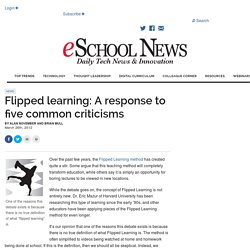
Over the past few years, the Flipped Learning method has created quite a stir. Some argue that this teaching method will completely transform education, while others say it is simply an opportunity for boring lectures to be viewed in new locations. While the debate goes on, the concept of Flipped Learning is not entirely new. Dr. Eric Mazur of Harvard University has been researching this type of learning since the early ’90s, and other educators have been applying pieces of the Flipped Learning method for even longer. It’s our opinion that one of the reasons this debate exists is because there is no true definition of what Flipped Learning is.
Dr. Thayer method of instruction at the United States Military Academy: A modest history and a modern personal account, The. Thayer-Method. Teachers 'flip' their lectures, homework to reach more students. The idea is that by working on 'homework' in class, teachers and students get more out of their time together.
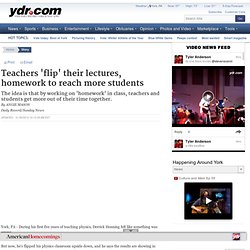
York, PA - During his first five years of teaching physics, Derrick Henning felt like something was wrong. He just couldn't reach some students with some concepts. But now, he's flipped his physics classroom upside down, and he says the results are showing in students' grades and attitudes. "I feel better doing this now than I had felt teaching physics the rest of the time," he said.
Henning is one of several York County educators who have adopted the "flipped classroom" model of teaching. It essentially means swapping what's traditionally done at home and in class. The concept has grown popular recently. There are advantages and limitations, he said. From the left, Chase Taylor and Allie Smith discuss a physics problem projected on a screen with teacher Derrick Henning last month at Spring Grove Area High School.
How teachers flip Some had watched. Figuring out flipping. The Flipped Classroom Model: A Full Picture. Due to Khan Academy’s popularity, the idea of the flipped classroom has gained press and credibility within education circles.
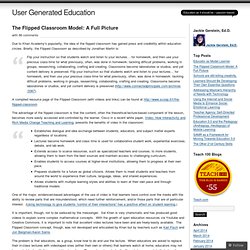
Briefly, the Flipped Classroom as described by Jonathan Martin is: Flip your instruction so that students watch and listen to your lectures… for homework, and then use your precious class-time for what previously, often, was done in homework: tackling difficult problems, working in groups, researching, collaborating, crafting and creating. Classrooms become laboratories or studios, and yet content delivery is preserved.
Flip your instruction so that students watch and listen to your lectures… for homework, and then use your precious class-time for what previously, often, was done in homework: tackling difficult problems, working in groups, researching, collaborating, crafting and creating. Classrooms become laboratories or studios, and yet content delivery is preserved ( How 'Flipping' the Classroom Can Improve the Traditional Lecture. This is from the Chronicle of Higher Education and discusses how instructors are reinventing the lecture.
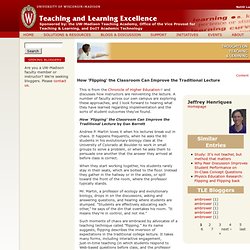
A number of faculty across our own campus are exploring these approaches, and I look forward to hearing what they have learned regarding implementation and the sorts of student outcomes they've found. How 'Flipping' the Classroom Can Improve the Traditional Lecture by Dan Berrett Andrew P. Martin loves it when his lectures break out in chaos. It happens frequently, when he asks the 80 students in his evolutionary-biology class at the University of Colorado at Boulder to work in small groups to solve a problem, or when he asks them to persuade one another that the answer they arrived at before class is correct. When they start working together, his students rarely stay in their seats, which are bolted to the floor.
Mr. Such moments of chaos are embraced by advocates of a teaching technique called "flipping. " The recent interest is driven by the convergence of several trends. Mr. Mr. Should You Flip Your Classroom? At its core, "flipped instruction" refers to moving aspects of teaching out of the classroom and into the homework space.
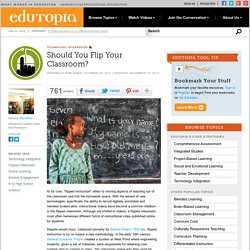
With the advent of new technologies, specifically the ability to record digitally annotated and narrated screencasts, instructional videos have become a common medium in the flipped classroom. Although not limited to videos, a flipped classroom most often harnesses different forms of instructional video published online for students. Despite recent buzz, catalyzed primarily by Salman Khan's TED talk, flipped instruction is by no means a new methodology. In the early 19th century, General Sylvanus Thayer created a system at West Point where engineering students, given a set of materials, were responsible for obtaining core content prior to coming to class. The classroom space was then used for critical thinking and group problem solving.